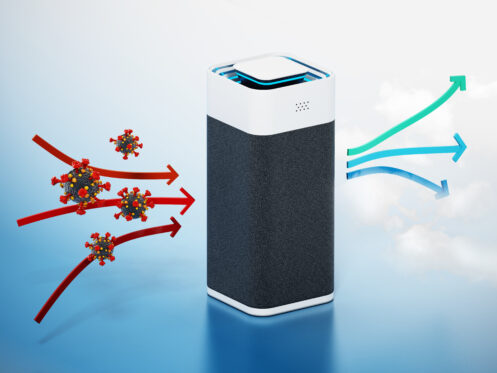Taking time to identify and fix airflow problems in a multi-story building is key to making the structure more comfortable. It may even help reduce allergy symptoms and respiratory issues in some people by minimizing allergens and dust. If you operate a business, improving airflow in the workspace can result in a more productive environment for you and your employees. Better airflow can also contribute to a healthier workspace by reducing the spread of airborne contaminants and pathogens, potentially lowering the risk of illness among employees.
Understanding Airflow in Multi-Story Structures
Factors, including temperature differentials, building architecture and ventilation systems impact the vertical and horizontal patterns that airflow normally follows in multi-story structures. Cool air tends to settle on lower floors, while warm air rises to upper levels, creating natural airflow pathways. But there are a number of things that can get in the way of airflow, such as poorly planned ventilation systems, furniture that blocks air vents and insufficient air circulation between levels. Debris and dust can accumulate in air ducts and filters, reducing ventilation effectiveness and cutting down on airflow. Closed or blocked windows, doors that aren’t airtight and ineffective HVAC systems can all hinder airflow as well.
1. Ensure Proper Ventilation Systems
Good ventilation removes stale air, odors and contaminants, improving indoor airflow and quality and reducing the health risks of polluted air. Ventilation also aids in controlling humidity and temperature, making the interior a more pleasant and comfortable place to be. In addition, preventing condensation—which may lead to structural damage, health hazards and the growth of mold and mildew—is another important function of good ventilation.
2. Add Natural Ventilation
There are several ways to incorporate natural ventilation to improve airflow in multi-story buildings. One approach is to design the building with operable windows that occupants can open to allow fresh air to enter and circulate throughout the space.
Incorporating atriums, courtyards and skylights can facilitate natural airflow by creating channels for air to flow vertically through the building. It’s also possible to make use of landscape elements and building orientation to maximize exposure to prevailing winds and promote natural ventilation.
3. Cross-Ventilation Design
Cross ventilation involves the natural flow of air through a building, facilitated by openings on opposite sides of the space. This airflow occurs as cooler, denser air enters the building from one side, displacing warmer, lighter air and pushing it out through openings on the opposite side.
To incorporate cross ventilation in multi-story buildings, designers can strategically position windows, doors and vents on opposite sides of the building to create airflow pathways. Skylights, clerestory windows and transom windows are great for cross ventilation because they let hot air go out and cold air in. Leveraging building layouts that allow for unobstructed airflow between floors, such as open atriums or stairwells, can further enhance cross ventilation and improve airflow throughout the building.
4. Use Air Circulation Fans
A variety of air circulation fans are available, each of which you can use for a specific purpose: to enhance the airflow in buildings with several stories. The horizontal and vertical circulation of air by ceiling fans helps disperse the conditioned air more evenly and eliminates hot spots. The gentle breeze created by the fans also promotes evaporative cooling, making occupants feel more comfortable without the need to lower the thermostat.
You can increase airflow and provide targeted cooling or ventilation with the help of portable choices, including floor fans, pedestal fans and tower fans. Another option for improving airflow and circulation between levels is to attach fans to the wall in stairwells, hallways and common areas throughout the building. Using fans instead of mechanical ventilation systems may even help save electricity while also improving airflow.
5. Ductwork Inspection and Cleaning
Clogged ducts hinder HVAC system performance, constraining airflow due to the buildup of dust, debris and other pollutants over time. The increased air resistance often leads to higher energy consumption, resulting in more expensive utility bills. Moreover, compromised airflow exacerbates indoor air quality issues and temperature inconsistencies. To maintain maximum circulation throughout the structure, building owners should invest in yearly duct inspections and cleanings to remove contaminants from the ductwork.
6. Airflow Monitoring Systems
Airflow monitoring systems utilize sensors to track airflow patterns and air quality levels throughout the building, providing valuable data for HVAC system optimization. By monitoring airflow in real-time, building managers can identify areas with poor ventilation or air stagnation and take proactive measures to address them promptly. Airflow monitoring systems can also help detect potential HVAC system malfunctions or inefficiencies, allowing for timely maintenance and repairs to prevent downtime and ensure uninterrupted airflow.
7. Airflow Direction Control
Adjusting dampers and vents allows building managers to regulate airflow direction and distribution based on occupancy levels, temperature requirements and air quality considerations. Implementing zoning systems further enhances airflow direction control, allowing for tailored ventilation strategies to meet the unique needs of different building zones.
8. Use of Air Deflectors
Air deflectors attach to HVAC vents and redirect airflow to ensure even distribution throughout the building. Adjustable air deflectors allow building occupants to customize airflow direction and distribution to suit their preferences, enhancing comfort and satisfaction. These deflectors also help improve HVAC system efficiency by ensuring that conditioned air reaches its intended destination without obstruction.
9. Proper Furniture Placement and Use of Window Coverings
Improperly positioned furniture can block air vents and obstruct airflow pathways, leading to stagnant air and temperature inconsistencies. Similarly, heavy or bulky window coverings, such as thick curtains or blinds, can impede airflow by preventing fresh air from entering the space.
To enhance airflow, place furniture away from air vents and windows to allow for unobstructed airflow. Consider arranging furniture along interior walls rather than blocking vents or windows. Opt for lightweight and breathable window coverings, such as sheer curtains or blinds, to ensure the air can circulate freely while still providing privacy and light control.
10. Install Air Purification Systems
Poor indoor air quality can have detrimental effects on airflow in multi-story structures. The accumulation of dust, allergens and pollutants in the air can clog air filters and ducts, hindering airflow and reducing ventilation efficiency. Excessive humidity levels can lead to condensation and mold growth, further obstructing airflow and causing potential health hazards. Turn to us for air purification solutions.
To improve airflow and indoor air quality in multi-story buildings, you may want to consider installing an air purification system. High-efficiency particulate air (HEPA) filters are highly effective at capturing airborne particles, including dust, pollen and pet dander, thereby enhancing airflow and reducing indoor air pollution. UV-C air purifiers utilize ultraviolet light to kill bacteria, viruses and mold spores, preventing them from circulating in the air and improving ventilation. Activated carbon filters help remove odors and volatile organic compounds, further enhancing indoor air quality and airflow in multi-story structures.
Do you need help tackling airflow problems in a multi-story building in Las Vegas, NV? If so, Bumble Breeze can help. Our company offers a variety of plumbing, HVAC and indoor air quality services for commercial spaces.


